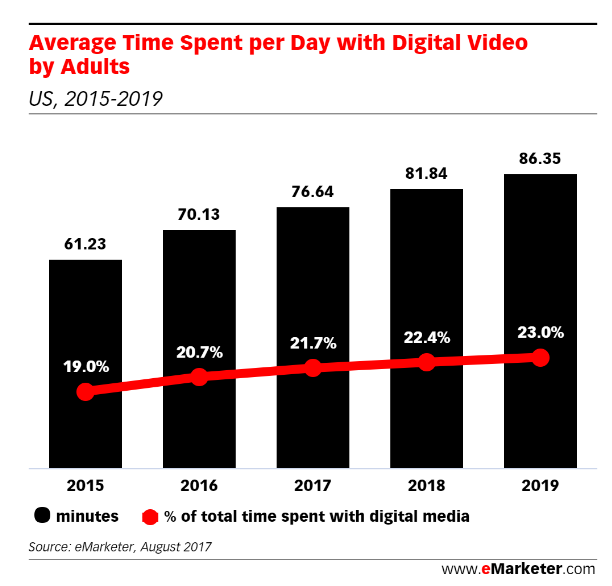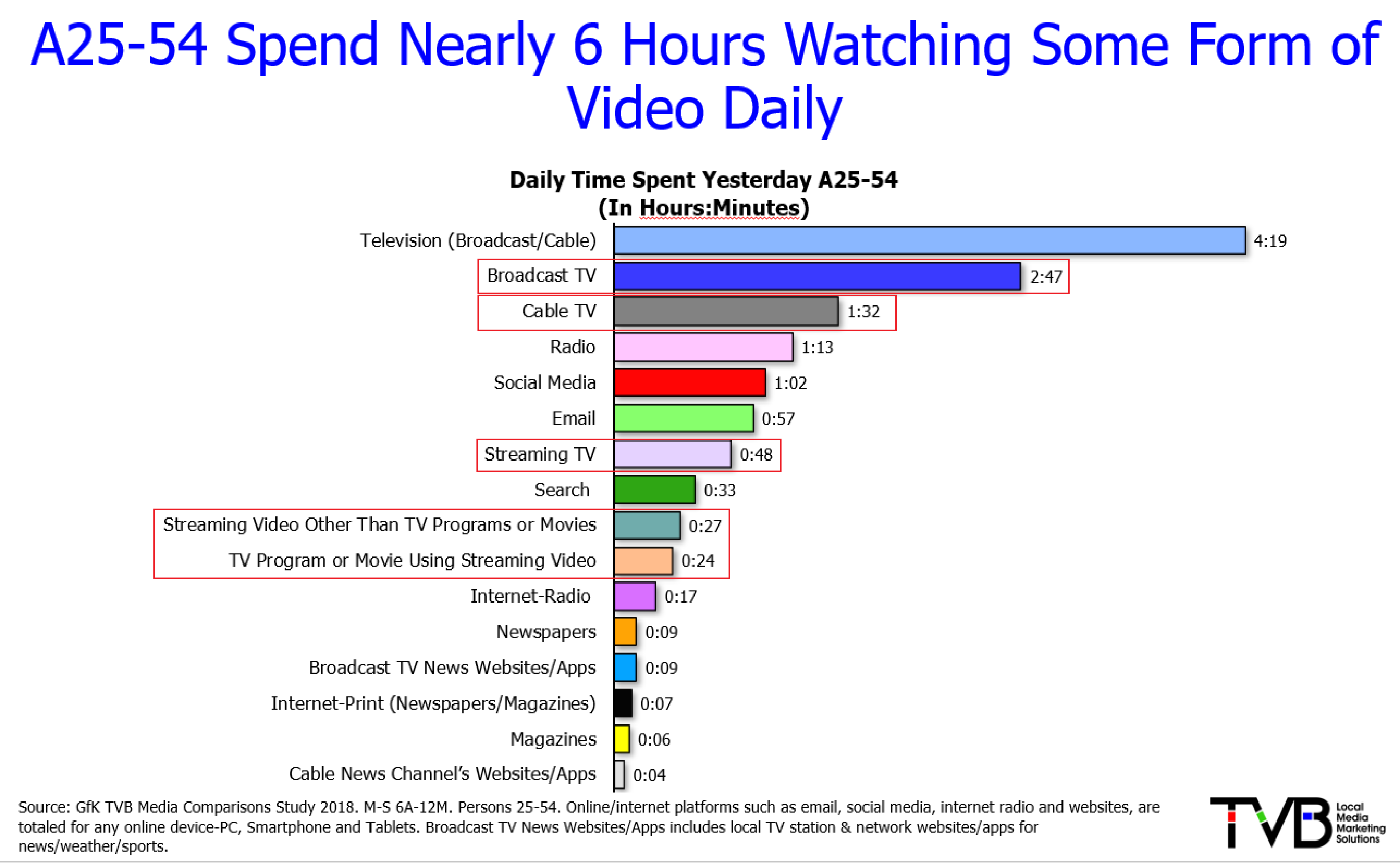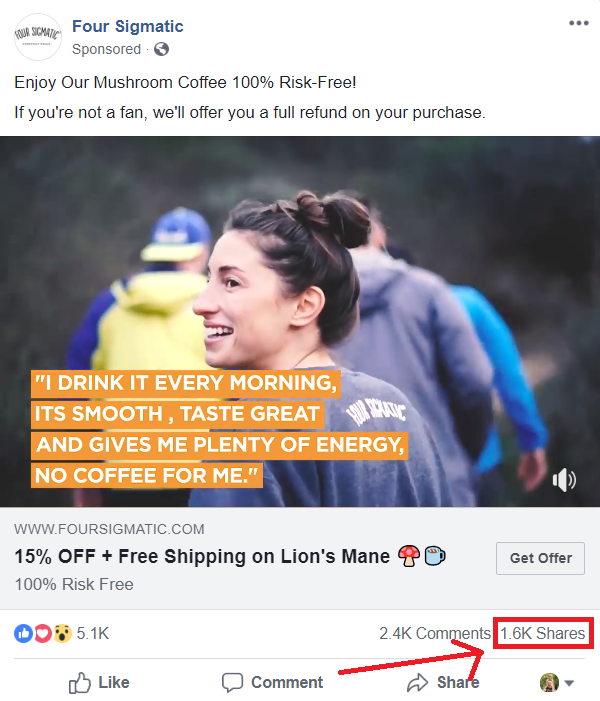Video is no longer an option. If your business is not using video advertising, here is proof you need to start.
Video advertising comes in all shapes and sizes: 30-minute infomercials, 5-second YouTube ads, the good-old-fashioned 30-second TV spot, 1-3 minute social videos, the list goes on. How do you decide where to start? The point is, it doesn’t matter (as much) which videos you’re creating, but that you have something going. There are more ways to access video content and more screens to watch the content on than ever before. People who think still think about video in terms of “TV versus Digital” need to update their mindset.
The marketers of yesterday would ask themselves, “Should we do TV advertising?” or “We already run some search ads on Google and some Facebook Ads. Does it make sense to also do YouTube or Facebook Video ads?”
Today’s savvy marketers are asking themselves, “What is our video strategy? How do we define the customer segments we are trying to reach? What story elements do we want to communicate about our brand/product/service? What is our desired business outcome of these (and any of our) ads?”
Big brands understand this and have been in this game for a long time (since July 1, 1941 to be precise), but many small and midsize businesses (SMBs) still don’t have a comprehensive video strategy.
The main challenges I hear from SMBs about starting or improving their video ad strategy are they:
- Don’t understand the impact video ads will have to their bottom line
- Don’t know how to create compelling video creative that will generate desired business outcomes
- Perceive the costs to create videos and pay for the media to run them will outweigh the benefits
- Think video advertising is best suited for companies bigger than their own
Well my dear SMB friends, there is a mountain of supporting evidence for why you should be starting or refining your video ad strategy right now.
Powerful Reason # 1 – Consumers are not just watching video, they are devouring it.
Consumers are watching more video than ever before. Just think about your own life. Have you seen some sort of video in the last 24 hours? Did you watch the news on TV? Stream an episode of your favorite show? Open up any social media app on your phone and see a video in your feed?
If your own habits aren’t convincing enough, consider these statistics:
82% of all internet traffic will be video by 2022, up from 75% in 2017, according to Cisco.
Pause. We’re talking about ALL internet traffic here. Every email typed and read, every news article published, every tweet, every webinar, every Instagram pic, every online purchase, every Venmo transfer, every blog post, every Google Image Search… everything! And 82% of that will be video soon?! Stop for a moment and look at your right hand. If all the traffic on the entire internet were your hand, then the only part that’s not video is your thumb. Whoa. (And if you’re one of these people thinking, “well hey, opposable thumbs are pretty great, you’re right, but that’s not the point and you know it.)
Of all time adults spend with digital media (computer, phone, email, everything digital), 23% of that time is watching video, up from 19% in 2015 (eMarketer).
This adds up to over 86 minutes a day spent just on digital video.

Adults 25-54 report spending nearly 6 hours per day watching video (TVB Media Comparison Study 2018)
The primary demographic most businesses market to, Adults 25-54, watch a ton of video. It’s important to look at market data and not just think about your own habits, as you as an individual are likely not representative of the marketplace overall.

Side note: Video is not just for B2C businesses; studies show buyers of business products are influenced by video during their B2B purchasing journey. Read this comprehensive resource – State of Video in Business – for B2B Video put together by Vidyard.
Powerful Reason #2 – Video evokes an emotional response. In marketing, emotion is power.
Video can make a person feel something unlike any other medium can. Why is that? For one, it activates multiple senses. “The whole is greater than the sum of its parts” applies. The audio from media like radio or podcasts can be used to communicate a story, explain several feature-benefits, tell a joke, use a distinct voice that aligns with your brand, and even have a catchy jingle or soundtrack playing in the background. But those of us who are visual people (i.e. every non-blind person) miss out on seeing the characters in the story or the product at work. On the flip side, visual media like a print ad, direct mail piece, a digital banner, or a billboard allow us to see your product, your logo, and space for a few words to give your offer (20% off during our President’s Day Sale) or your brand message (I’m Lovin’ It). Both visual and audio media have something to offer, but when was the last time a billboard made you emotional? Start to tear up? When was the last time a radio ad left you feeling energized? Motivated?
Watch this example from one of the masters of the internet, Google, to see the power of video when you combine incredible visuals and captivating sound all wrapped into an elegant and timely story line.
[youtube https://www.youtube.com/watch?v=6aFdEhEZQjE&w=560&h=315]
I’ve watched this video over a dozen times, and every time it makes me feel something. Hope for humanity. Joy. Pumped up. Whatever you are feeling right now, live in that feeling for a moment. A video did that. You can (and should) be moving your customers in the same way.
Powerful Reason #3 – You can tell a story in a video. Stories are what sparks a connection in us.
Ever heard the phrase “a picture is worth 1,000 words?” If that’s true, then how many words are a video worth? Answer: at least 1.8 million words, says Dr. James McQuivey from a Forrester study. Here’s a cool graphic from idearocket explaining McQuivey’s logic.

A 60-second video is worth approximately 1.8 million words
No matter how you quantify it, the point is you can communicate a lot of information with a video. But it’s not just the quantity of information that matters, it’s also the ability to tell a story.
Stories matter. They have been told since before written language as a way to pass information down through the generations. As humans, we are drawn to stories because we see ourselves reflected in them, and they broaden our perspective.
Savvy marketers tap into this deep-rooted psychological craving for stories influence customers at their core.
Here’s a big budget example from Comcast. The spot is called “Emily’s Oz.” In it, Emily, a a little blind girl, tells us her story of what she sees when she watches The Wizard of Oz.™
[youtube https://www.youtube.com/watch?v=ZU7NU_fsaSU&w=560&h=315]
That video is a story about a story – talk about smart storytelling in an ad!
Don’t have as big of a production budget as Comcast, but still want to tell a story through video? It’s more than possible!
Here’s a commercial produced for a local financial planning and investment management firm Nepsis. Viewers see the story of a typical person with some money invested who does not have perfect clarity over all the charts, graphs, and figures in the monthly statement from their current financial planner – Vague Financial Advisors.
[youtube https://www.youtube.com/watch?v=5qeNBW1LOWs&w=560&h=315]
Notice how the beginning of the video starts with a story, but the end brings it home with a call to action for the viewer. That’s how to execute storytelling with video that will generate an impact for a local business.
Powerful Reason #4 – One Video Can Be Distributed Across Many Platforms. On Many It Can Be Shared.
Yes, it takes some effort to make a high quality video ad. But once you’ve made one, that one video asset can be used across many platforms. There are so many outlets available for you to share your video and get it in front of a target audience; some are free, some are paid.
- Your website
- Your social channels (Facebook, Instagram, LinkedIn, Twitter, SnapChat…)
- Broadcast TV
- Connected TV
- Paid Social
- YouTube
- In an Email Campaign
- Vimeo
- In a blog post
- Pre-roll video on an ad network like Audience Marketplace or Google AdSense.
- On a product landing page.
- Directly on any website with video content and pre-roll ad units. For example, let’s say the profile of your best customers aligns with the audience of a top-100 website like ESPN, or with a local newspaper or TV station. Go directly to that business and purchase pre-roll video inventory.
Now you might be thinking, “Sure my video ad can be placed in many places, but so can my print ad, radio spot, or billboard. I can make one print ad and run it in the big city newspaper, the local newspaper, and six different magazines. I can cut one radio spot and run it on five stations plus Spotify. All I need is one billboard and that can be plastered all over town.”
This is all true. But can you share a billboard with a friend? Can you post a radio ad to everyone connected to you on a social network? Sure, you could rip out a newspaper ad from the paper and hand it to your bestie, or really get crazy with extending the reach of your share by taping the newspaper ad to your workplace refrigerator. This is all assuming you would feel want to share any of these in the first place.
To contrast, let’s take a look at this Facebook Video ad from Four Sigmatic, which I found by opening Facebook just now and scrolling down my feed for roughly four seconds.
Here’s the part to note.

This fairly straightforward video ad for coffee has been shared 1,600 times. It’s one thing for a business to put out a piece of really useful/helpful/entertaining content for its audience and earn some shares, but an ad? You can pay to run an ad and reach a target audience, and then those people will market your product to their friends? For free? Yes, it turns out people are willing to share an video ad with their friends if it’s great creative, includes a compelling offer, or they know someone who might be interested in the product. So what does having a shareable ad mean for your business?
The average number of Friends a Facebook user has is 338 (Pew Research).
1,600 Shares x 338 Friends per User = 540,800 Extra Customers Potentially Reached
And this is just one social network. Multiply this videos reach out across three other social platforms where users can share a video ad (YouTube, Twitter, LinkedIn)… now the advertiser is reaching millions of potential customers and paying to reach absolutely zero of them.
Powerful Reason #5 – Video is Versatile.
Video is a versatile medium where you can shape your brand perception, generate leads, get people to visit a website, showcase a client testimonial, drive inbound phone calls, show your product being used, make customers laugh (or tear up)…
Better yet, you can do all of the above in the same ad!
Here’s an example from a local business that does a great job of connecting with the customer in a real way, while also mentioning the company name multiple times, and they even have their phone number in the video title!
[youtube https://www.youtube.com/watch?v=CcBKbpfgjVE&w=560&h=315]
Powerful Reason #6 – Video Improves Virtually Every Advertising Metric (KPI)
You already do lots of marketing activity, like: managing your website, updating your company blog, sending out email campaigns, creating social posts, orchestrating all your advertising, and 16 (+/- 10) other projects. Want a surefire way to boost the performance of all of these activities? Video is your answer!
Social Video
- Videos are shared 1,200% more than Links and Text combined (ClumCreative)
- Facebook video posts get 135% more organic reach than an image post. (SocialBakers)
- Square-shaped social videos can achieve 45% more engagement than landscape videos (HubSpot)
Search Engines
- Video drives a 157% increase in Organic Traffic from SERPs (ClumCreative)
- With roughly 25% of Google search results being a video, you can occupy extra spaces on the SERP if you put your video on YouTube and optimize it. (ClumCreative)
Email
- Video leads to a 200-300% increase in click-through rate (HubSpot)
- Emails that include the word “video” in the subject line boost their Open Rates by 19% and reduce Unsubscribes by 26% (HubSpot)
Landing Pages
- Need to convert website visitors into leads or customers? Adding a video to your landing page can up its conversion rate by 56%. (Neil Patel)
B2B
- 86% of Business-related video views happen on a desktop (Vidyard, 2018)
- Tuesday Mornings are the most popular time for B2B video views, from 10AM – 1PM EST (Vidyard, 2018)
Powerful Reason #7 – Video Ads Have Been Proven to Deliver Tangible Business Results.
If your business isn’t very active with any form of video advertising, then you might be skeptical about it’s ability to impact your bottom line. Management is always asking Marketing, “This [insert any marketing idea: a social campaign, an event, a new series of video ads] sounds like a great idea, but what is the direct benefit we’ll get from this?” And Marketing had better have a good answer, or the project idea never leaves the conference room.
Fortunately, with video, there is a good answer. “It’s been proven to work.” Now, every situation may have a different definition of “work,” but most businesses I consult are looking for more: website traffic, new leads, and sales.
Tuft and Needle has grown to $100M in annual revenue, and while they started out spending only $50-100 a day on marketing, they now spend half of their Google advertising on YouTube. “It gets results,” the founders said. (YouTube)
[youtube https://www.youtube.com/watch?v=Zwn0uLtcKVk&w=560&h=315]
On a smaller scale, family-owned local company Sedgwick Heating & Air was trying to figure out how to generate more leads during a slow demand time for their industry. They created a video ad and ran it on television in a high-frequency pattern. Here is the owner speaking about the results.
[youtube https://www.youtube.com/watch?v=XIGoJ6_8F-A?start=9&w=560&h=315]
Conclusion
The time is now for businesses of all sizes and industries to embrace video. Watching video is where we spend our time. Videos are the most compelling way to tell a story, appealing to multiple senses and evoking an emotional response from the viewer. They improve every measure of marketing performance and have proven to increase sales for companies big and small across industries.
If you haven’t started with video ads, start! If you have, do more!
————–
I’d really like to know your feedback on this article. Leave a comment!
If your business isn’t doing any video advertising right now, what is the main reason it’s not? Don’t see the benefit? Sounds like a lot of work with no payoff? Don’t know how to start? Something else?








